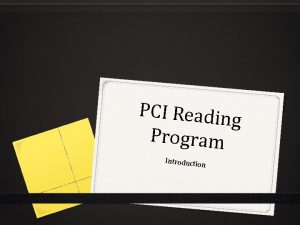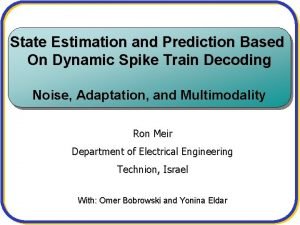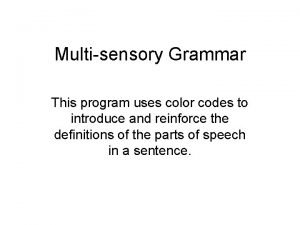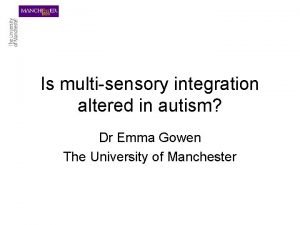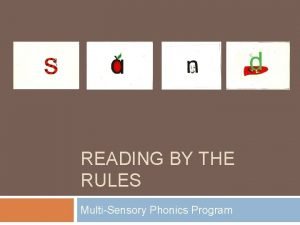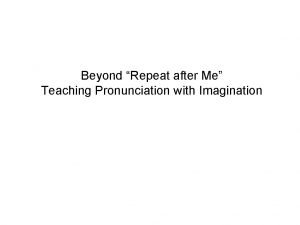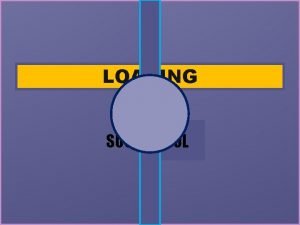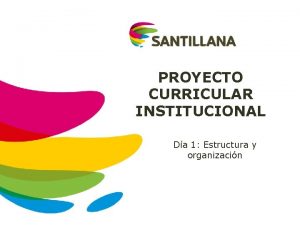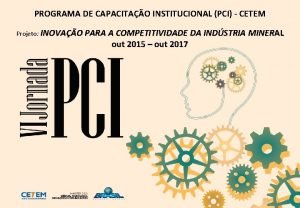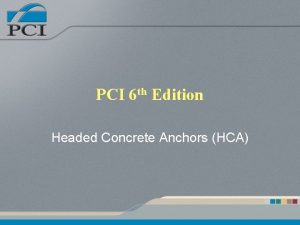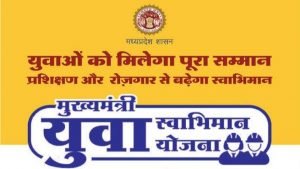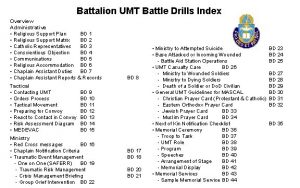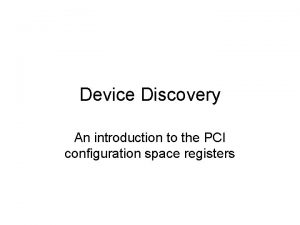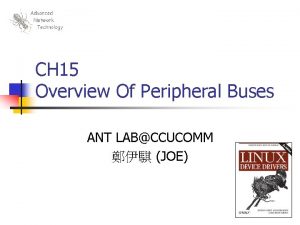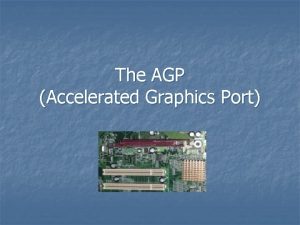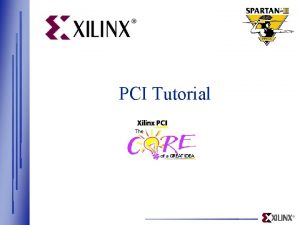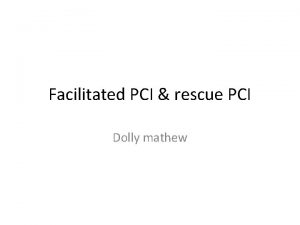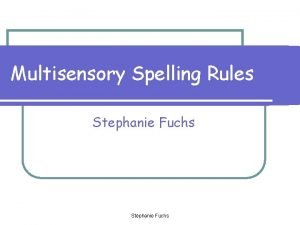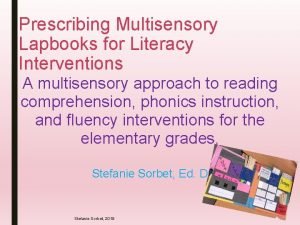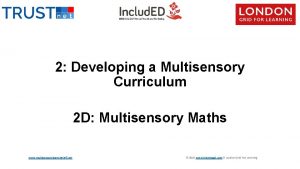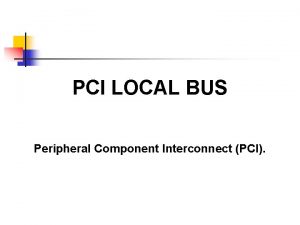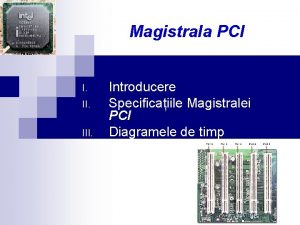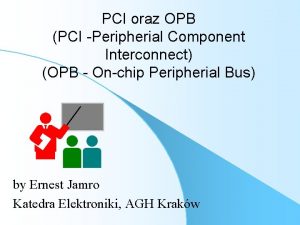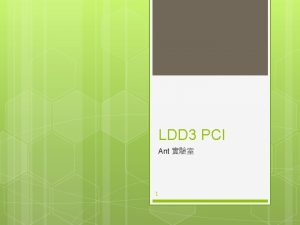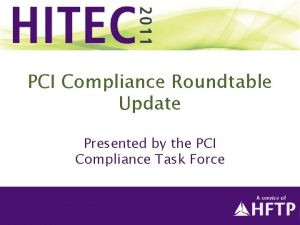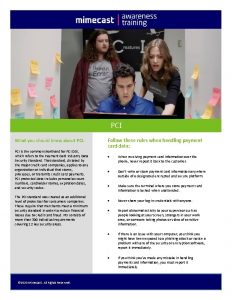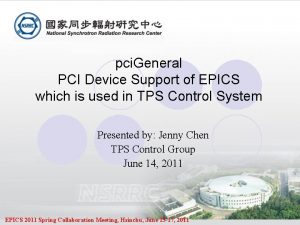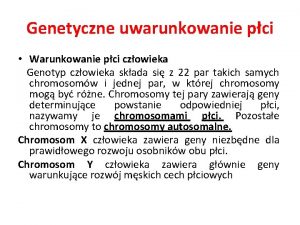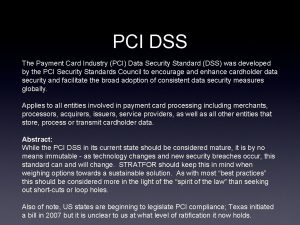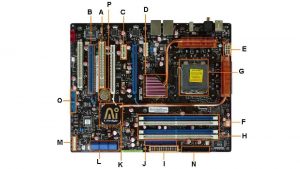PCI Reading Program Introductio n Rationale 0 Multisensory


























- Slides: 26

PCI Reading Program Introductio n

Rationale 0 Multi-sensory phonetic approach is preferred method and usually first choice. 0 Think of some of the processes used when reading. 0 Visual discrimination of letters, identification of letters, phonemic awareness (that letters represent sounds in our spoken language), the recognition that our words are made up of smaller units of sound, association of correct sounds with the letters, stringing those sounds together to read a word. 0 26 letters/44+ sounds 0 Lots of processing, lots of practice

Rationale 0 After practice, this processing becomes quicker and not as difficult. Students with reading disabilities need intensive, systematic instruction to learn to read. Brains of children with reading disabilities are “inefficient” in how they process the written word. Fluency is very difficult. 0 After learning the decoding process, strong readers do not decode or sound out words. Once mastered, they become essentially a sight word – a word recognized immediately upon seeing it. These strong readers only use their decoding skills when they see an unfamiliar word.

Rationale 0 For many students with processing disorders, developmental delays, and/or cognitive impairment the processing takes so long, that by the time they have sounded out a word, they have lost it. It is too cumbersome of a task. 0 Years of non-progress (doing the same curriculum repeatedly without success) creates low motivation, low self esteem, and aversion to reading and school work. 0 With constant repetition, relevance, and exposure to a word, students learn the “whole” word by sight without going through the decoding process.

Some examples Pizza

PCI Reading 0 Scientifically research based curriculum that helps turn nonreaders into successful readers. 0 Created for students with developmental disabilities, autism and significant learning disabilities. 0 Become readers through a system of 0 0 REPETITION, ERRORLESS DISCRIMINATION, CONTROLLED READING, and HIGH INTEREST ACTIVITES

REPETITION 0 The use of repetition and review to ensure both short- and longterm retention of the words taught. 0 Most basal and other mainstream reading programs provide 8 to 12 repetitions of a sight word or other vocabulary word to be learned. 0 Quality intervention reading programs often provide 30 or more repetitions. But for students with developmental disabilities and significant learning differences, short- and long-term memory is often one of the problems that make it difficult to learn and retain skills. 0 With these students in mind, the authors carefully constructed the activities to include over 100 practice and review opportunities for every word taught. 0 Words are introduced and reviewed continually in every step of the program. This repetition is varied, involving every major learning modality, including visual, auditory, and tactile/kinesthetic

Errorless Discrimination 0 One known word, one new word 0 Find/Discriminate between New word with different words

Controlled Reading 0 All the books students will be reading include only the words the students have learned.

High interest activities 0 In the program 0 DIR important for us to infuse in our activities as well while at the same time following the program and the intent of the steps involved. 0 Research is based on doing the program as intended, however supplementation/modifications may be necessary.

Level 1 0 0 -Grade 1, Non-readers 0 Learn to automatically recognizing 140 words including sight words and common nouns and verbs through visual discrimination. 0 All Level 1 materials are carefully controlled to include only words they have learned. 0 Student reads a BOOK after every five words taught.

Level 2 0 Grade 1. 0 to 2. 0 -2. 5 0 Students learn an additional 140 words. 0 Students also learn important early reading skills including 0 “reading” wrapped text, 0 recognizing end punctuation marks, and 0 recognizing common inflectional endings such as –s, ing, and –ed. 0 Students READ a book after every 10 words taught

Level 3 0 From 2. 0/2. 5 – 3. 0/3. 5 0 Considered a “bridge” 0 This level moves students from visual discrimination to use of basic decoding and word attack skills. 0 Prepares students for reading other reading materials outside of the program.

Pro’s & Con’s

ASSESSMENT!!!! 0 Administer the comprehensive test 0 Gives a baseline to see how many of the words the student knows of the 140 words. 0 Test 20 at a time. 0 Test informally at any time. 0 Do NOT try and help them sound out or help in assessment. 0 Fill out comprehensive test checklist 0 Continually assess throughout the program.

Level 1 Lesson Cycle at a Glance 0 0 0 Laminate it! Step 1 – Learn a word through a 4 part cycle Step 2 – Repeat Step 1 for four more words Step 3 – Review words with the Word Game Step 4 – Assess word retention through a post test Step 5 - Read a book 0 * Note – Designed for special education in regular ed. Setting/school 0 * “Teacher Scripts” for the entire program are given

Step 1 A (Identify, descriminate) 0 Purpose of 1 A is to be able to identify the word when they see it. 0 Pick it out of a list of other words. 0 Find it 0 Supplemental Activities? (find the word around the room, hide and seek, …. . )

Step 1 B- multisensory 0 Trace with pen, pencil or finger – kinesthetic learning 0 Then read it. 0 Uses pictures for words not yet taught i. e. flower, bus 0 Purpose is for the multi-sensory 0 In Lindamood Bell, we “air write”. Very good activity to do! 0 Activities? (shaving cream, Play-doh, raised dots, etc…. . )

Step 1 C: practice, practice & connect 0 Guided Word Practice 0 Using Word card, picture cards, plastic word tray 0 Complete a Read-Aloud in Guided Word Practice Book 0 Real-world connection (relevance) ex: You can use the word “this” when pointing to things…. . 0 Activities? 0 Pictures from home, drawings, etc…. 0 Create own book with connections 0 “Match on the Mat” board.

Step 1 D- Independence 0 Reinforcement 0 Independent work 0 Can use for independent work stations and homework

Step 2 0 Repeat the cycle for 4 more words. 0 One word at a time 0 Repetition, multisensory, practice, relevance, and independent work!

Step 3 0 The Word Game 0 Make some other games with the 5 words also! Have students make their own sentences with them, other words they may know and pictures! 0 Ideas?

Step 4 0 Posttest 0 After every 5 words. 0 Word not mastered should be reviewed again through the activities in Step 1.

Step 5 0 Read a book! 0 Controlled vocabulary books. 8 -12 pages long. 0 Book Lessons with comprehension lessons/activities.

Building Reading Skills Binder 0 Supplemental lesson plans and activities. 0 5 units 0 0 0 Building Visual Skills Building Attention Building Memory Building Concepts of Print Building Phonemic Awareness

Review 0 Video on PCI Reading Level 1 Cycle 0 http: //www. pcieducation. com/reading/cycle. aspx
 Rationale in reading program
Rationale in reading program Multisensory integration examples
Multisensory integration examples Multisensory grammar color code
Multisensory grammar color code Multisensory input
Multisensory input Multisensory phonics
Multisensory phonics Multisensory pronunciation
Multisensory pronunciation Are contrived experiences multisensory
Are contrived experiences multisensory While reading activities
While reading activities Pci goal
Pci goal Vanjska sabirnica
Vanjska sabirnica Redual
Redual Que es el proyecto curricular institucional
Que es el proyecto curricular institucional Pci cetem
Pci cetem Datakiosk
Datakiosk Minimum edge distance
Minimum edge distance Mmksy registration
Mmksy registration Umt confession
Umt confession Controller acquisizione dati e elaborazione segnali pci
Controller acquisizione dati e elaborazione segnali pci Palin parent child interaction
Palin parent child interaction Tailor pci
Tailor pci Agp pci
Agp pci Pci traumatisme cranien
Pci traumatisme cranien Niveaux pci dss
Niveaux pci dss Pci class codes
Pci class codes Pci bridge
Pci bridge Accelerated graphics port year created
Accelerated graphics port year created Pci tutorial
Pci tutorial
